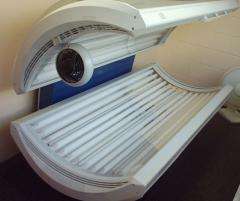Tanning devices cost US healthcare $343 million a year

Tanning devices cost the US $343.1 million a year in medical costs because of the skin cancers their use is associated with, according to a new study published in the Journal of Cancer Policy. In a new study, Dr. Hugh Waters and his colleagues from the University of North Carolina established how prevalent indoor tanning-related skin cancers are in the US, and calculated the costs of these diseases.
They estimate that in 2015 there were 263,600 cases of skin cancer that could be attributed to indoor tanning. These cases cost US $343.1 million in medical costs in 2015, and cause a total economic loss of $127 billion over the lifetime of the people affected. The authors conclude that effective policies and strategies are needed to reduce the use of tanning devices, in order to mitigate their significant health and financial impacts.
There is strong evidence that tanning devices cause skin cancer. They emit UV radiation; UV-A damages cells and DNA, causing skin cancer, and UV-B causes burning and contributes to skin cancer. In addition, there are several other diseases linked to indoor tanning, including dermatitis, keratitis and porokeratosis. Despite this, the proportion of people in the US who use indoor tanning devices has risen over the last 20 years; an estimated 30 million people now use the devices at least once a year, in the approximately 25,000 tanning salons across the country.
"Skin cancer is the most common cancer in the US and its incidence is increasing, due in part to the increase in the use of tanning devices," said Dr. Waters. "We know these devices have significant health and financial impacts, and with this study we wanted to establish these impacts clearly to support efforts to reduce their use, especially among younger people."
The researchers focused on three types of skin cancer: cutaneous melanoma, basal cell carcinoma and squamous cell carcinoma. They identified the total number of cases in the US in 2015 and worked out how many of these cases were likely due to the use of tanning devices, by using data on prevalence of use of tanning devices and previously published estimates of relative risk - the likelihood of having the disease for people who use tanning devices compared to people who don't. There were 9,000 cases of melanoma, 86,600 cases of squamous cell carcinoma and 168,000 cases of basal cell carcinoma that could be attributed to the use of tanning devices.
They then estimated the healthcare cost of these cases, based on the average annual cost of treating patients with each of the diseases. This resulted in an estimated cost of US $343.1 million a year in medical costs. By working out the years of potential life lost due to the diseases, and the average lost earnings per person, they also determined the cost of working time missed due to the conditions. These productivity losses amounted to US $127 billion over the lifetime of the people who had the conditions attributable do tanning devices in 2015.
"Our calculations are all conservative, so this is the lower end of the estimate - the impact could be even higher than this," said Dr. Waters. "Tanning devices cause hundreds of thousands of people to suffer a number of different diseases, costing billions of dollars and, most importantly, people's lives. We hope that our results will help in the efforts toward reducing the use of tanning devices."
More information: "The Health and Economic Implications of the Use of Tanning Devices," by Hugh R. Waters, Journal of Cancer Policy, volume 12 (2017), DOI: 10.1016/j.jcpo.2016.12.003



















